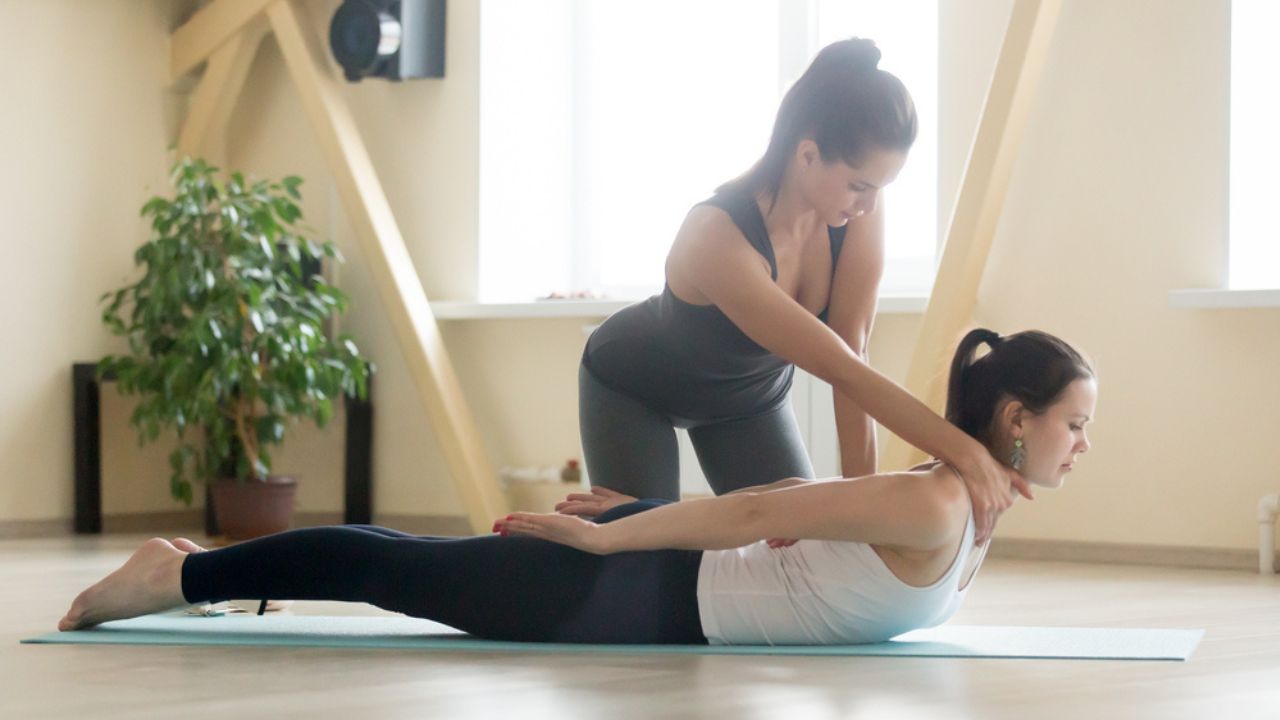Locust pose, also known as Salabhasana in Sanskrit, is one of the prominent backbends that is commonly used for deeper backbend poses like camel pose, pigeon pose, bow, cobra pose, and others. This pose is also often practiced after Surya-namaskar or sun salutation while beginning the yoga session or as a part of the vinyasa flow, giving you a good stretch and opening your chest. A foundational and favorite of yogis, the Locust pose resembles the locust insect’s shape and has a range of benefits.
The Locust pose is often considered a preparatory pose for other advanced asanas and is one of the most beginner-friendly poses. However, that doesn’t take away from the multitude of benefits it offers for physical, emotional, and mental well-being.
Read on to learn how to perform Salabhashasana or the locust pose and the many benefits it offers.
How to Perform Locust Pose: Steps And Tips

Like most yoga postures, you don’t require any equipment for performing this asana, except a good-quality yoga mat.
Step-by-Step Guide to Locust Pose
While it may appear to be an easy pose, one might find it tricky to hold onto the correction position. If you are a beginner, it’s best to perform this under the guidance of your instructor. Meanwhile, here are the steps for doing the pose and some tips to perfect it:
- Start with lying down on your stomach with your forehead and chin touching the mat. Keep your arms by your side and your feet stretched backward.
- As you begin, try to focus on the bend rather than the lift. You should lengthen your lower back and allow the pubic bone to press against the floor. Simultaneously lift your belly and feel a pull in the naval area.
- Pay attention to your breathing while slowly lifting your head, chest, and arms. Inhale as you lift and roll back your shoulders, and keep the chest open as well.
- Keep the arms straight, thumbs pointing down (towards the floor), and try to reach out towards the back wall or as if someone is pulling your hands from behind.
- Aiming the lower body, lift the knees off your mat and engage the leg muscles without tightening the hips too much.
- Depending on your body’s movements and flexibility, vary the legs’ posture. You can either keep pressing the top of the feet on the mat or lift the toes up too, lifting the whole body higher.
- Keep your neck in a neutral position by keeping the gaze on the floor. This will prevent the back of your neck from crunching.
- You can stay in the position for five breaths, embodying a calm demeanor along with rhythmic breathing.
Tips for Beginners for Practising Locust Pose Yoga
- Rolling back your shoulder blades and opening the chest while lifting the arms is highly necessary. Always ensure that your shoulders are not slouched.
- Do not bend your knees, as it will put a lot of strain on your lower back.
- To prevent neck crunching, keep your neck in a neutral position. Keep the neck long and do not push your shoulders towards the ears.
- If you require, keep a brick under your feet for support and an effective position.
6 Benefits of Locust Pose for Body And Mind

Whether you are able to do only a half locust pose or are already into deep back bending, the benefits of locust pose or salabhasana will instantly make it your daily to-do for the yoga roster. The stretch of the locust pose helps one in both physical and internal betterment. Take a look at the multi-purpose pose which has a lot to offer beyond its preparatory properties.
1. Strengthens Back and Core Muscles:
The focus area for the locust pose is the back and core muscles. It efficiently stretches and strengthens them, while also enhancing the spine posture and its mobility (1).
2. Improves Posture:
Mundane activities like prolonged sitting generally cause slouching and abnormal curvature of the spine. Practicing salabhasana counteracts this, by extending the spine and improving the overall back posture (1).
3. Improves Muscle Tone:
With locust pose, your glutes, calves, adductors, and hamstrings are also well stretched, toned, and strengthened (1).
4. Boosts Inner Composure and Energy:
Holding this position with mindful breathing helps you achieve a balanced composure and you may feel a bout of energy from within.
5. Boosts the Digestive System:
As one presses the pelvic area on the floor while practicing locust pose, there is pressure on the abdominal regions and the organs like the spleen and liver are massaged through it. This strengthens the muscles, induces appetite, enhances digestion, and helps with gastric issues (2).
6. Relieves Symptoms of PMS:
For women, the locust pose can be immensely helpful for premenstrual syndrome. It is pretty common for many women to experience physical and psychological issues before and during the week of menstruation. Salabhasana along with some other asanas was found to help relax the body and mind. As the yoga postures massage the internal organs and relieve tensed muscles, it helps a great deal in relieving stress and anxiety brought on by hormonal changes (3).
Conclusion
Time and again, yoga has proven its multi-faceted benefits for people across the globe. Here we have reviewed and shed some light on the locust pose which is proven to be a stepping stone for practising deep backbends. Locust pose or salabhasana has many other benefits to its list, like core strengthening, toning muscles, helping digestion, and many more. It is always recommended to practice this pose with some guidance, especially for beginners. People with arthritis, back or neck injury, and pregnant women should avoid practicing this pose.
ALSO READ: Lotus Position: All About the Foundational Yoga Pose


0 Comments
Post a Comment